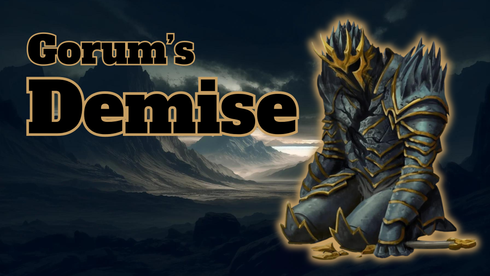
Dungeon Crawls Are the Worst Type of Adventure
Look, dungeon crawls had their day. But lets move on from that. No, you won't agree with me, but at least you can read about my thoughts!
Dungeon crawls have long been a staple of tabletop roleplaying games (TTRPGs). I'm currently running Abomination Vaults for a group, and for Pathfinder 2E, it IS the dungeon crawl. Ten levels of dungeon. Now, the classic image of adventurers delving into dark, monster-infested caverns in search of treasure is iconic. However, only some find these adventures appealing. In fact, for some players, dungeon crawls can be the least enjoyable type of TTRPG adventure. Here’s why:
Repetitive Gameplay
One of the most common criticisms of dungeon crawls is the repetitive nature of the gameplay. Typically, a dungeon crawl involves a cycle of entering a room, fighting monsters, searching for treasure, and solving traps or puzzles. While this formula can initially be exciting, it can quickly become monotonous. "Oh hey, look, another room of monsters..... yaaayyyyy."
Imagine spending several hours of a gaming session moving from one nearly identical room to another, each time encountering a similar group of monsters. The lack of variety in these encounters can make the game feel like it’s on a loop. This repetitive structure can be a major turn-off for players who crave variety and dynamic scenarios, potentially leading to disengagement from the session.
Let's be honest, there are some people out there that live for this type of dungeon. Yes, I know, and there are people out there who love licorice. (Author's note, I love licorice.) And that's fine and all, but the repetition can get old. Especially if it feels a bit "samey" as you run through it. This can lead to a situation where players may disengage from the session, resorting to distractions like browsing Reddit instead of actively participating in the game.
Limited Roleplaying Opportunities
Dungeon crawls are often heavily focused on combat and exploration mechanics, which can come at the expense of roleplaying opportunities. In a typical dungeon crawl, there’s less emphasis on character interaction, story development, and moral dilemmas. This can be frustrating for players who thrive on the narrative aspects of TTRPGs.
For example, a dungeon crawl might involve characters solving a series of mechanical puzzles to advance, with little room for character backstories or personal growth. Conversations with NPCs might be limited to essential exchanges about traps or enemy weaknesses, leaving little space for meaningful dialogue or character-driven storytelling. And yes, this does come down to how the GM leads the campaign. But what can happen, even when the GM has the best intentions, is that the roleplaying interactions end up less enthusiastic than those outside the dungeon.
Jumping back to my Abomination Vaults game, multiple instances of roleplay have happened in the town of Otari. But those instances felt very surface-level. In the end, the group always knew they were heading back to the Vaults to kill more things. The adventure never took them to new locations, and with new locations come new roleplaying opportunities.
Linear Structure
Many dungeon crawls are designed with a linear structure, where players move through a predefined series of rooms or areas. This linearity can limit player agency and creativity, making the game feel like a series of predefined challenges rather than an open-ended adventure.
Consider a dungeon where the path is clearly marked, and every room must be cleared in a specific order. Players might feel like their choices don’t matter as the adventure pushes them down a set path with little room for deviation. This linearity can be disappointing for those who enjoy sandbox-style games with open-ended exploration and multiple solutions to problems.
There can be some fixes to this. A dungeon with multiple entrances allows players to make more choices. Having your dungeon loop around with various places to visit from a single hallway means the adventurers can drive the narrative. The GM has to prepare for this. Abomination Vaults does do a good job regarding player agency. There are multiple entrances to each floor and multiple exits. The floors themselves loop around, allowing the player to choose who and what they encounter first.
Overemphasis on Combat
Dungeon crawls often emphasize combat encounters, which may not appeal to all players. While tactical combat can be thrilling, it’s not everyone’s cup of tea. Some players prefer problem-solving, diplomacy, or non-combat-oriented gameplay; dungeon crawls can feel restrictive.
In a dungeon crawl, players might find themselves in combat after combat, with little opportunity to use their characters’ other skills or abilities. This focus on fighting can overshadow other aspects of the game, such as negotiation, stealth, or creative problem-solving. For players who prefer a more balanced approach to adventuring, this can make dungeon crawls feel one-dimensional.
Now, players who know they are joining a dungeon crawl will create a specific character. But even then, there will be skills that are not used as often. And if the focus is always on combat, other games outside the TTRPG sphere are available that can give you the same satisfaction. In the end, though, communication with your players and making them aware of the style of TTRPG is important.
Resource Management Stress
Dungeon crawls frequently require meticulous resource management, such as tracking health, spells, and supplies. While some players enjoy the challenge of managing resources carefully, others find it stressful and tedious.
Imagine a long dungeon where every spell slot, healing potion, and piece of ration must be accounted for. Players might spend as much time tracking their inventory as they do exploring the dungeon. For those who prefer a more relaxed gaming experience or who find the bookkeeping aspects of TTRPGs less enjoyable, this constant resource management can be a major downside.
And that doesn't even include running out of spells and immediately returning to town to rest after two encounters. Yes, this has happened. And yes, it feels odd every time. If the rolls are bad they may even head back after one encounter. And then you're just playing wack-a-mole as a ttrpg.
Final Thoughts
While dungeon crawls can be immensely enjoyable for players who appreciate tactical combat, strategic planning, and the thrill of discovery, they aren’t for everyone. The repetitive gameplay, limited roleplaying opportunities, linear structure, overemphasis on combat, and resource management stress can make them less appealing to certain players. As always, aligning the adventure style with players' preferences is the key to a successful TTRPG experience. By understanding the potential drawbacks of dungeon crawls, game masters can better tailor their campaigns to ensure everyone at the table has a great time.




